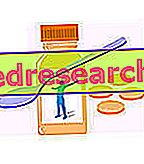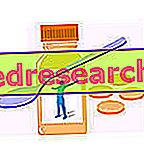Generality
Algodystrophy is a chronic condition characterized by intense, continuous and extremely debilitating pain, affecting an upper or lower limb.
The precise causes of algodystrophy remain a question mark. According to some doctors, at the origin of the condition in question there would be a simultaneous malfunction of several systems of the human body, including the nervous system, the immune system and the circulatory system.

In addition to pain, algodystrophy can be responsible for: alterations in the appearance of the skin, alterations to the hair or nails, strange sensations in the affected limb, tremors, joint stiffness, joint swelling, etc.
In severe cases, algodystrophy can seriously compromise quality of life.
Currently, there is no specific cure for algodystrophy, but only a series of symptomatic treatments.
What is algodystrophy?
Algodystrophy, less known as a complex regional pain syndrome, is a chronic condition characterized by the presence of extreme pain in a limb or parts of an upper or lower limb.
Arms, legs, hands and feet are absolutely the anatomical regions of the human body most affected by algodystrophy.
Causes
Currently, despite numerous studies on the subject, the precise causes of algodystrophy remain a mystery. According to the hypotheses of some experts, this condition derives from a contemporary malfunction of several systems of the human body, including in particular:
- The central nervous system → includes the brain and the spinal cord;
- The peripheral nervous system → is the set of nerves and nerve cells that do not constitute the brain and spinal cord;
- The immune system → is the set of organs and cells responsible for defending the body from viruses, bacteria, fungi and other threats (eg: mad cancer cells);
- The blood circulatory system → is the complex of arteries and veins, which carries blood into the human body.
The idea that these systems would be implicated arises from the observation that, in subjects with algodystrophy, the functions controlled by the aforementioned systems are altered. For example, among the altered functions there is the transmission and perception of the pain sensation, which is under the careful control of the central and peripheral nervous system.
FAVORABLE FACTORS
By studying the causes of algodystrophy, pathologists have found that - very often (more than 90% of cases) - the condition is associated with injuries such as: bone fractures, burns / burns, cuts and sprains / joint distractions.
FORMS OF ALGODISTROFIA
Some experts claim the existence of two forms of algodystrophy: algodystrophy I (or complex regional pain syndrome I) and algodystrophy II (or complex regional pain syndrome II).
According to the supporters of the aforementioned thesis, the parameter that distinguishes the two forms of algodystrophy is the dependence on a previous injury to the nervous system.
More specifically, all the episodes of algodystrophy preceded by an injury of the nervous system are forms of algodystrophy II, while all the episodes of algodystrophy that have not been preceded by injuries of the nervous system are forms of algodystrophy I.
Does genetics affect you?
In the past, some doctors had advanced the hypothesis that genetic factors also affected the onset of algodystrophy.
However, the researchers who in the following years did their utmost to prove the aforementioned hypothesis, failed, finding no connection between algodystrophy and genetics.
IS IT A PSYCHOLOGICAL CONDITION?
Also in the past, some pathologists considered algodistrophy and pain, which it caused, a disorder of a psychological nature.
Today, the aforementioned theory is no longer taken into consideration.
Symptoms, signs and complications
The main symptom of algodystrophy is a limb pain or a part of it.
The pain induced by algodystrophy is often an intense, persistent and debilitating sensation; many patients also describe it as a burning or stinging sensation.
The painful sensation can last for several days or weeks; it can suddenly disappear and reappear with the same unpredictability.
In describing the pain of algodystrophy, doctors often use the terms allodynia and hyperalgesia .
In medicine, these two terms indicate exaggerated responses to stimuli that cause pain. Specifically, we talk about allodynia when an individual experiences pain even after mild stimuli and that, in normal conditions and in good health, they would be completely harmless.
Instead, the word hyperalgesia is used to indicate all those situations in which there is hypersensitivity to painful stimuli.
OTHER SYMPTOMS
In addition to chronic pain, algodystrophy can cause:
- The strange feeling that the limb or part of the painful limb does not belong to the rest of the body;
- The strange sensation that the painful limb (or a part of it) seems larger or smaller than the painless contralateral limb;
- Alterations in the appearance of the skin, where the patient complains of pain. The painful region may turn red, be hot and dry or cold, turn blue and sweat;
- Alterations of the hair and nails (nails of the affected limb). Hair and nails can grow more slowly or faster than normal;
- Joint stiffness and swelling. The joints involved are those belonging to the painful limb;
- Tremors and muscle spasms (dystonia);
- Difficulty moving the painful limb;
- Insomnia;
- Bone fragility (osteoporosis) at the level of the painful limb.
PHYSICAL COMPLICATIONS
In rare circumstances, algodystrophy can lead to complications of a physical nature, such as: skin infections, skin ulcers, muscle atrophy and muscle contractures.
Those who are victims of these complications have considerable difficulty in moving and leading a normal life.
PSYCHOLOGICAL COMPLICATIONS
In people with algodystrophy, the presence of chronic, continuous and high intensity pain is often responsible for psychological problems, including depression and anxiety .
In cases where the pain sensation is extreme, the psychological problems could be of such a magnitude that the patient tries to commit suicide.
WHEN TO REFER TO THE DOCTOR?
A valid reason for concern and for which it is advisable to contact your doctor is the presence of a persistent pain, which prevents the carrying out of the simplest daily activities.
Diagnosis
Diagnosing algodystrophy is not easy at all. There are at least three reasons why it is difficult to identify the condition in question:
- A specific diagnostic test is missing;
- The symptomatology is very similar to that of other pathological conditions;
- The causes are not clear; consequently the doctors ignore which physiological anomaly is to be sought.
The most common diagnostic procedure, to which patients with suspected algodystrophy are subjected, provides:
- An accurate physical examination and a careful anamnesis, to evaluate in depth the symptomatological picture.
Continuous and persistent pain is a symptom whose presence is fundamental, but it is not the only important clinical manifestation of algodystrophy.
- Blood tests, to categorically exclude that the symptoms depend on some infectious disease;
- A nuclear magnetic resonance (NMR), to exclude that the symptomatology depends on the presence of problems with the bones or soft tissues;
- An X-ray examination, to exclude that the symptoms are due to joint or bone problems;
- Nerve conduction studies, to exclude that the symptomatology derives from damage to one or more nerves
The use of diagnostic tests to exclude possible background conditions (eg blood tests to exclude the presence of infections) is a particular method of investigation, which takes the specific name of differential diagnosis .
To diagnose a condition such as algodystrophy, proceeding by exclusion is probably the most adopted and most effective strategy.
Therapy
Currently, algodystrophy is a condition for which there are no specific cures, but only treatments aimed at alleviating the symptomatic situation ( symptomatic therapy ).
For specific care, doctors intend a therapy capable of acting specifically on the present condition and its causes, bringing the patient to recovery.
The symptomatic therapy of algodystrophy includes, mainly, physical (physiotherapy), pharmacological and psychological (psychotherapy) treatments.
PHYSICAL THERAPY (OR PHYSIOTHERAPY)
In the case of algodystrophy, physical therapy consists of a program of physiotherapy rehabilitation exercises, aimed at improving blood circulation, joint motility and elasticity and strength of muscles in the painful limb.
The purpose of physical therapy is to allow the patient to perform normal daily activities without experiencing pain.
In order for physical therapy to be truly effective, doctors advise contacting a physiotherapy expert on algodystrophy.
PHARMACOLOGICAL THERAPY
Among the drugs that doctors prescribe in case of algodystrophy, include:
- Non-steroidal anti-inflammatory drugs, also called NSAIDs . They are medicines that, by acting against inflammation, reduce pain. Examples of NSAIDs are aspirin, ibuprofen and naproxen;
- Corticosteroids . They are powerful anti-inflammatories, whose prolonged use can have serious side effects (eg: osteoporosis, diabetes, cataracts or obesity). Common corticosteroids prescribed in case of algodystrophy are prednisolone and methylprednisolone;
- Anticonvulsants . These drugs are specifically indicated for the treatment of epilepsy.
The most commonly administered anticonvulsants in case of algodystrophy are gabapentin and pregabalin;
- Tricyclic antidepressants . They are medicines specifically indicated for the treatment of depression.
In the case of algodystrophy, amitriptyline and nortriptyline appear to have an effect;
- Opioids, such as oxycontin, morphine, hydrocodone or fentanyl. They are powerful analgesics. Their prolonged or reckless use has various side effects, including: nausea, vomiting, constipation, dry mouth, fatigue, cognitive problems, depression, amenorrhea in women and erectile dysfunction in men;
- NMDA receptor antagonists (N-Methyl-D-Aspartate), such as dextromethorphan or ketamine;
- Local anesthetics in the form of creams, containing lidocaine.
PSYCHOLOGICAL THERAPY
Doctors recommend a psychological therapy (or psychotherapy) to all those subjects who, following algodystrophy, have developed psychological problems, including depression, anxiety, post-traumatic stress disorder, etc.
One type of psychotherapy that is very popular among patients with algodystrophy and psychological problems is the so - called cognitive-behavioral therapy .
OTHER TREATMENTS
Less common forms of symptomatic treatment of algodystrophy are:
- The so-called sympathetic nerve block (or blockade of the sympathetic nervous system ). It involves the injection, near the spinal cord, of an anesthetic, capable of blocking the activity of one or more nerves of the sympathetic nervous system.
With the aim of reducing the intensity of the painful sensation, the sympathetic nerve block produces temporary analgesic effects. In the long run, in fact, it is not effective.
- Sympathectomy . It is the surgical removal of one or more structures constituting the sympathetic nervous system. In theory, its execution should result in a reduction in pain intensity; in reality, it is useful to some patients, while for others it is counterproductive.
- Spinal cord stimulation . It involves the installation of some stimulating electrodes on the spine, in the extreme vicinity of the spinal cord, and the use of a device capable of activating the aforementioned electrodes.
Performed by activating the electrodes on the spine, stimulation of the spinal cord should change the pain sensation, making it less intense.
- The so-called intrathecal pumps . They are medical devices used to administer small amounts of analgesic or anesthetic drugs in CSF.
The purpose of intrathecal pumps is to reduce the intensity of the pain sensation.
SOME TIPS ON HOW TO CHECK THE ALGODISTROFIA
According to the doctors, to better control the algodystrophy would be appropriate:
- Inquire about the characteristics of the condition, so as to understand it better;
- Keep active with the painful limb; avoid immobility;
- Learn some pain control techniques;
- Learn some relaxation techniques, to improve the quality of life;
- Try your hand at physiotherapy treatments at home. Running them only in specialized centers has limited benefits;
- Attend support groups for people with algodystrophy or similar disorders.
Prognosis
The prognosis in case of algodystrophy varies from patient to patient.
Some patients respond positively to therapies, others respond little or do not respond at all.
According to some studies, if the treatments begin when the algodystrophy is at the beginning, the prognosis is better.
It is common opinion in the scientific community that only the discovery of the precise triggering causes will allow doctors to identify a specific cure for algodystrophy.



